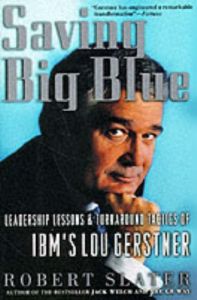Melden Sie sich bei getAbstract an, um die Zusammenfassung zu erhalten.

Melden Sie sich bei getAbstract an, um die Zusammenfassung zu erhalten.
Robert Slater
Saving Big Blue
Leadership Lessons and Turnaround Tactics of IBM's Lou Gerstner
McGraw-Hill, 1999
Was ist drin?
IBM was moribund, hidebound, and shopworn when Lou Gerstner rode in and revived it with revolutionary tactics: firing entrenched employees, flattening established bureaucracy, and selling solutions instead of products.
Recommendation
Listen, my children, and you shall hear the incredible saga of how IBM nearly died and was revived by Lou Gerstner. Robert Slater tells the tale of IBM’s turnaround after it nearly sank under the weight of institutionalized arrogance and failure to heed advancements in the industry it had dominated. Gerstner broke company tradition, fired employees who believed they had a sinecure, slashed a decade-old bureaucracy, and switched IBM’s focus from products to solutions. This action portrait shows a man smart enough and tough enough to rebuild an empire. The book’s lessons are artfully woven into the fabric of Gerstner’s personal story and IBM’s corporate history. getAbstract recommends this book to any high level executive whose organization needs a revolution or to any businessperson who wants a juicy reminder of what it takes to win the war of independence.
Summary
About the Author
Robert Slater has written for Time, Newsweek, and United Press International. He has also written a number of best selling business books.
























Comment on this summary